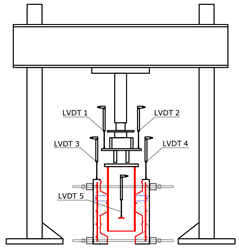Experimental study of angle type shear connectors in position L and V embedded in composite slabs with steel decks
DOI:
https://doi.org/10.51372/gacetatecnica232.6Keywords:
shear connector, angle type connector, push-out test, collaborating sheetAbstract
This article presents a study of angle-type shear connectors, as a new proposal for a monolithic work of the composite slab system with collaborating sheet, considering that there are currently no regulations that validate its use. The experimental analysis of 14 specimens with angle-type shear connectors positioned in plan at 90º (type L) and 45º (type V), tested with the Push-Out method established by Eurocode 4, is presented. Mechanical properties such as shear strength, ductility, and stiffness as a function of connector position, as well as failure mode. The results showed that the two groups of specimens have similar shear strength and ductility, differentiating between V-type connectors with a stiffness value 42% higher than differentiating between V-type connectors with a stiffness value those obtained in L-type connectors. The typical failure mode is due to premature cracking, of the concrete in the cross section of the slab. The results obtained for shear capacity are compared with some empirical expressions of international regulations and previous studies of similar connectors
Downloads
References
M. López, R. Larrúa y C. Recarey, “Un nuevo sistema de diseño de embuticiones en láminas de acero para maximizar resistencia de losas compuestas” Revista Ingeniería de Construcción, vol. 22, pp. 145-156, 2007, doi : 10.4067/S0718-50732007000300001
R. Zaki, J. Butterworth y C. Clifton, “Shear Stud Capacity in Profiled Steel Decks,” New Zealand Heavy Engineering Research Association, 2003
S. Shahabi, H. Ramlim Sulong, M. Shariati, M. Mohammadhassani y S. Shah, “Numerical analysis of channel connectors under fire and a comparison of performance with different types of shear connectors subjected to fire,” Steel and Composite Structures, vol. 20, nº 3, pp. 651-699, 2016, doi: 10.12989/scs.2016.20.3.651.
K. Khorramian, S. Maleki, M. Shariati y R. Sulong, “Behavior of Tilted Angle Shear Connectors,” PLoS ONE, vol. 10, nº 12, p. e0144288, 2015, doi: 10.1371/journal.pone.0144288 e0144288.
H. Yokota y S. Maleki, “Load Carrying Capacity of Shear Connectors made of Load Carrying Capacity of Shear Connectors made of Shape Steel in Steel-Concrete Composite Members,” PARI Technical Note 0595, 1987.
S. Choi, K. Tateishi, D. Uchida, K. Asano y K. Koba-yashi, “Fatigue strength of angle shape shear connector used in steel-concrete composite slab,” Int J Steel Struct, vol. 8, nº 3, pp. 199-204, 2008.
S. ROS y H. Shima, “Shear Force-Relative Displacement Relationships of L-shape Shear Connector Subjected to Strut Compressive Force,” コンクリート工学年次論文集, vol. 33, nº 2, pp. 1219-1224, 2011.
M. Shariati, N. Ramli Sulong, A. Shariati y M. Arabnejad Khanouki, “Behavior of V-shaped angle shear connectors: experimentaland parametric study,” Materials and Structures, vol. 49, nº 9, pp. 3909-3926, 2015, doi: 10.1617/s11527-015-0762-8 3909-3926.
L. M. Bezerra, O. O. Cavalcante, L. Chater y B. Jorge , “V-shaped shear connector for composite steel-concrete beam,” Journal of Constructional Steel Research, vol. 150, pp. 162-174, 2018, doi: 10.1016/j.jcsr.2018.07.016. 162-174, 2018.
D. Arévalo, H. Luis, C. Gómez, G. Velasteguí, E. Guaminga, R. Baquero y R. Dibujés, “Structural performance of steel angles hear connectors with different orientation,” Case Studies in Construction Materials, vol. 14, pp. 1-20, 2021, doi: 10.1016/j.cscm.2021. e00523 1-20, 2021.
N. Rehaman, D. Lam, X. Dai y A. Ashour, “Experimental study on demountable shear connectors in composite slabswith profiled decking,” Journal of Constructional Steel Research, vol. 122, pp. 178-189, 2016, doi: https://doi.org/10.1016/j.jcsr.2016.03.021
A. J. Wang, “Numerical Studies on Structural Behaviour ofShear Connectors in Push-Out Tests,” Australian Journal of Structural Engineering,, vol. 9, nº 2, pp. 76-96, 2009, doi: https://doi.org/10.1016/j.jcsr.2016.03.021 1080/13287982.2009.11465012.
J. Qureshi, D. Lam y J. Ye, “Effect of shear connector spacing and layout on the shear connector capacity in composite beams,” Journal of Constructional Steel Research, vol. 67, pp. 706-719, 2011, doi: https://doi.org/10.1016/j.jcsr.2010.11.009.
ANSI/AISC 360, Specification for Structural Steel Buildings., Chicago: American Institute of Steel Construction, 2016.
UNE-EN-1994., Eurocódigo 4: Proyecto de estructuras mixtas de acero y hormigón Parte 1-1: Reglas generales y reglas para edificios, Asociación Española de Normalización y Certificación (AENOR), 2013.
C39/C39M-20, Standard Test Method for Compressive Strength of Cylindrical Concrete Specimens, ASTM International, 2021.
AST International, E8/E8M Standard Test Methods for Tension Testing of Metallic Material, U.S.A.: ASTM Inf., 2010.
X. Hurtado, M. Molina y D. Linero, “Comportamiento de conectores de cortante tipo tornillo de resistencia grado dos para un sistema de sección compuesta,” Revista ingenieria e investigación , vol. 8, nº 2, pp. 4-14, 2008.
D. Ayala, C. Chicaiza, L. Hernández, G. Velástegui y R. Baquero, “Comparación del comportamiento entre conectores de corte angulares de diferente espesores bajo cargas monotónicas y cíclicas,” Gaceta Técnica , vol. 22, nº 2, pp. 3-22, 2021, doi: http://dx.doi.org/10.13140/RG.2.2.18659.27684.
W. Deng, Y. Xiong, D. Liu y . J. Zhang, “Static and fatigue behavior of shear connectors for a steel-concrete composite girder,” Journal of Constructional Steel Research, vol. 159, pp. 134-146, 2019, doi: https://doi.org/10.1016/j.jcsr.2019.04.031.
ASTM E178-16, Standard practice for dealing with outlying observations, West Conshohocken, PA: ASTM International, 2016.
A. Shariati, M. Shariati, N. Ramli Sulong, M. Suhatril, M. Arabnejad Khanouki y M. Mahoutian, “Experimental assessment of angle shear connectors under monotonic nd fully reversed cyclic loading in high strength concrete,” Construction and Building Materials, vol. 52, pp. 276-283, 2014, doi: https://doi.org/10.1016/j.conbuildmat.2013.11.036.
ASCE/SEI 41-17, Seismic evaluation and retrofit of existing buildings, American Society of Civil Engineers, 2017.
S. J. Hicks, A. Ciutina y C. Odenbreit, DEVELOPMENT OF A NEWPUSH TEST FOR EUROCODE 4 (LAC17.I), 2017.
GB50017-2003, Code for desing of steel structures., Beijing: China Architecture &, 2006.
H. Al-kroom, M. Thneibat, Y. Alghrir y V. Schmid, “An experimental investigation of new bent V-shaped shear connector,” Latin American Journal of Solids and Structures, vol. 18, nº 5, pp. 1-18, 2021, doi: https://doi.org/10.1590/1679-78256438.
F. Tahmasbi, M. Shervin, M. Shariati, N. H. Ramli Sulong y . M. M. Tahir, “Shear Capacity of C-Shaped and L-ShapedAngle Shear Connectors,” PLOS ONE, vol. 11, nº 8, 2016, doi: https://doi.org/10.1371/journal.pone.0156989

Published
How to Cite
Issue
Section

This work is licensed under a Creative Commons Attribution-NonCommercial-ShareAlike 4.0 International License.
The opinions expressed by the authors do not necessarily reflect the position of the editor of the publication or UCLA. The total or partial reproduction of the texts published here is authorized, provided that the complete source and electronic address of this journal is cited. Authors have the right to use their articles for any purpose as long as it is done nonprofit. The authors can post on the internet or any other media the final approved version of their work.






.png)




